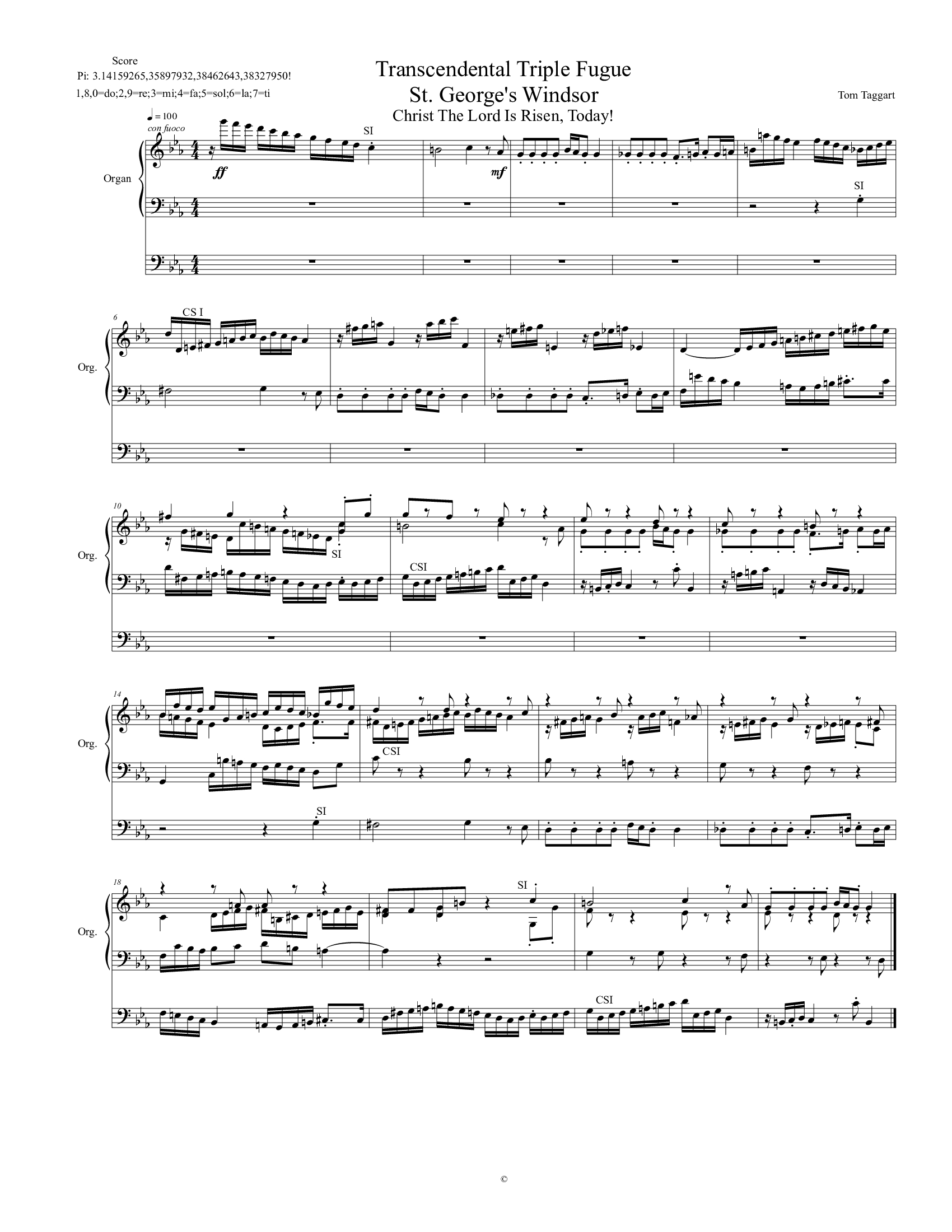Transcendental Triple Fugue, St. Georges Windsor
A dazzling Easter fugue interweaving the digits of pi with hymn melody in a transcendent musical celebration.
About This Piece
Built on the joyful Easter hymn Christ the Lord Is Risen Today and the transcendental mystery of the number π (pi), this triple fugue is both an intellectual marvel and a resounding expression of faith. The work unfolds in three distinct fugal movements, each layered with symbolic and musical meaning, culminating in a triumphant, multifaceted coda that defies the listener to remain unmoved. At its core, the piece seeks pattern in the seemingly patternless—drawing on the digits of pi to generate melodic material, which then intertwines with phrases of the St. George's Windsor hymn. The result is a constantly evolving tapestry of counterpoint: chromatic descent, motivic repetition, syncopated development, and explosive stretto passages all build toward a dramatic convergence. By the final moments, three fugue subjects, multiple hymn phrases, and 32 digits of pi coexist in a brilliant architectural finale. This is a work of exuberance and complexity—one that transforms number and theme into a jubilant, deeply reverent celebration of the Resurrection.
Piece Details
Notes from the Composer
Mathematicians have for centuries tried to find a pattern in Pi; recently, they have computed Pi to a billion decimal points. None has found a visible pattern; yet, there is a pattern if one listens to Pi. Pi cadences downward-by-step every eight decimals, hence—3.17159265, 35897932, 38462643, coming to rest at "do" in the final eight decimals: 38327950. Transferring the numbers 0-9 to solfeg, one arrives at the following: 1,8,0=do; 2,9=re; 3=mi; 4=fa; 5=sol; 6=la and 7=ti. Whereupon with this solfeg configuration, the composer constructed the Transcendental Triple Fugue, St. George's Windsor (Christ, The Lord, Is Ris'n Today!--SGW). The first fugue is in c minor with a very identifiable opening motif whereupon a series of repetitive notes follow. The counter-subject descends downward, chromatically. After the development section, the fugal subject enters, first as stated, then in inversion with Pi wrapped around them and leading to the SGW's first phrase. The second fugue uses SGW's first phrase as its subject. The counter-subject quietly contrasts with the first-fugue's countersubject. This fugue highlights in counterpoint the joy and triumph of our Risen Lord. The third subject is formed by Pi, using the first eight decimal points. Its development uses very mild syncopation in the lower voices whereupon another phrase of SGW appears in the alto voice. As this fugue comes to a close, the harmonized SGW's first phrase blasts forth. Then follows the first-fugue announcing itself with multiple stretti using many inversions. Next, the first subject appears along with the counter-subject's upward-driving motif against SGW's sixth phrase. The piece's coda places Pi to all 32-decimal points in the bass with the final augmented phrase in the soprano and the first-subject in the alto against free counterpoint in the tenor. Soli Deo Gloria.
Additional Notes
- •Numerical Basis: The fugue's third subject is based on solfège equivalents of the first 32 decimal digits of π—making audible what seems random on paper.
- •Layered Counterpoint: The final coda stacks multiple fugue subjects with hymn material and pi-based lines
- •Spiritual Symbolism: The use of mathematical structure to express divine mystery mirrors theological themes of resurrection, revelation, and cosmic order.
- •Performance Scale: At over 12 minutes and 300+ measures, this piece is ideal as a concert closer or major organ feature during Easter services.
